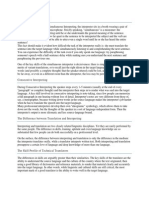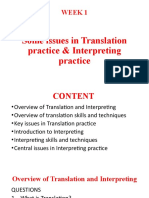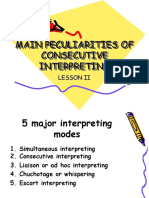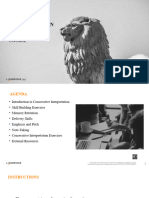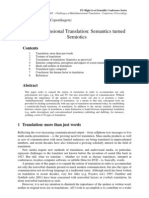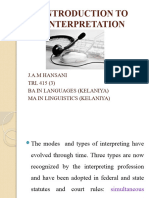0% found this document useful (0 votes)
240 views10 pagesSimultaneous Interpretation
The document discusses simultaneous interpretation, which is when an interpreter reformulates a speaker's speech into another language at the same time. It allows for speeches to be delivered naturally without stopping while also engaging diverse audiences. Some advantages are it saves time and allows the audience to benefit from non-verbal cues. However, it is not suited for two-way conversations. Skills needed for simultaneous interpretation include fluency in two languages, specialist terminology knowledge, active listening, strong memory, multitasking abilities, and cultural awareness.
Uploaded by
Hernandez CeledonCopyright
© © All Rights Reserved
We take content rights seriously. If you suspect this is your content, claim it here.
Available Formats
Download as PPTX, PDF, TXT or read online on Scribd
0% found this document useful (0 votes)
240 views10 pagesSimultaneous Interpretation
The document discusses simultaneous interpretation, which is when an interpreter reformulates a speaker's speech into another language at the same time. It allows for speeches to be delivered naturally without stopping while also engaging diverse audiences. Some advantages are it saves time and allows the audience to benefit from non-verbal cues. However, it is not suited for two-way conversations. Skills needed for simultaneous interpretation include fluency in two languages, specialist terminology knowledge, active listening, strong memory, multitasking abilities, and cultural awareness.
Uploaded by
Hernandez CeledonCopyright
© © All Rights Reserved
We take content rights seriously. If you suspect this is your content, claim it here.
Available Formats
Download as PPTX, PDF, TXT or read online on Scribd
/ 10



